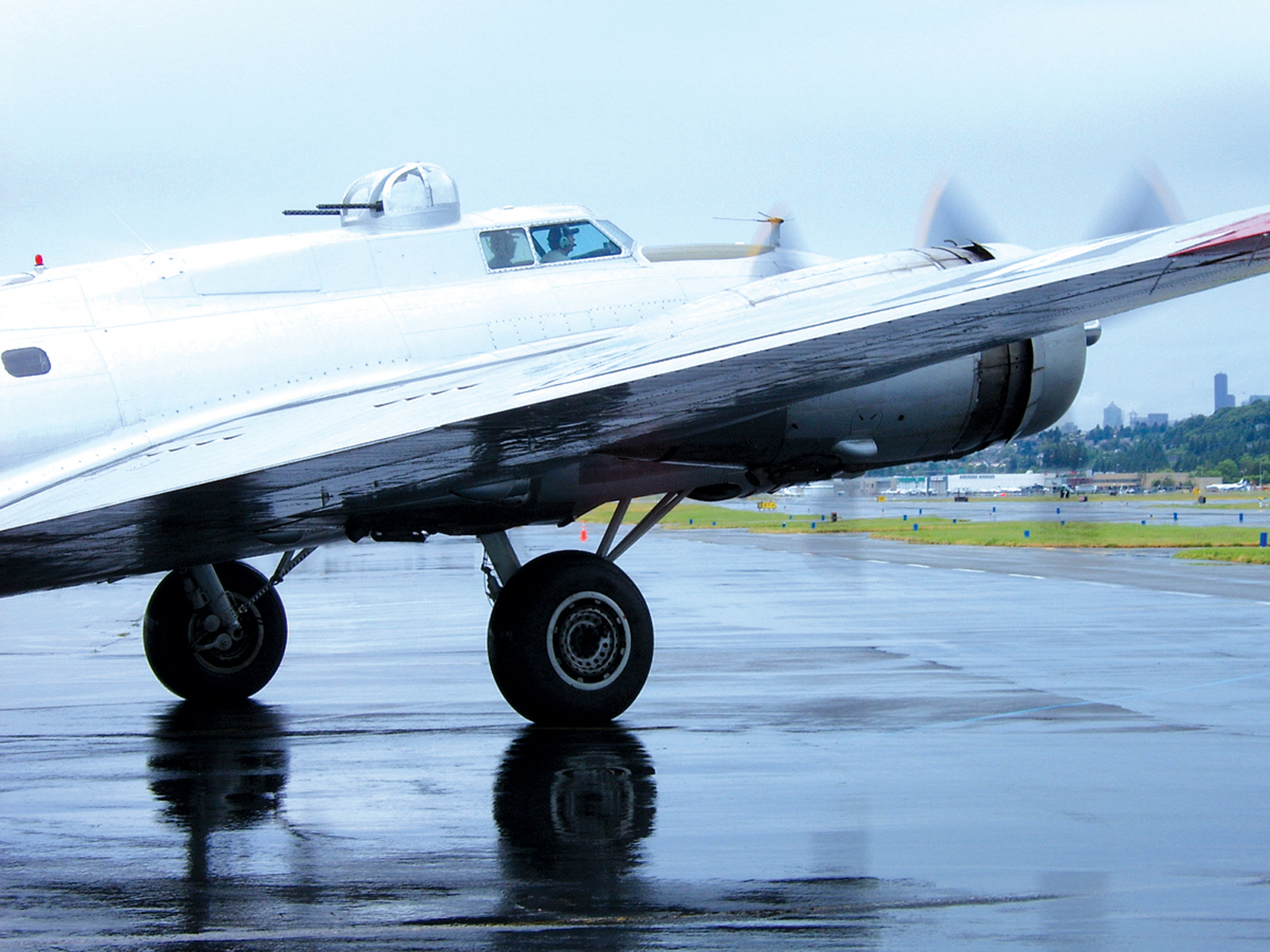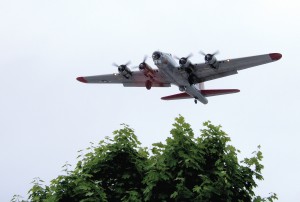By Christian Holtz
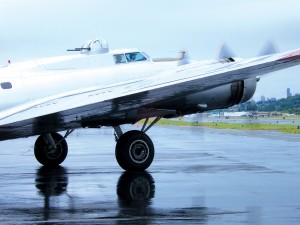
With its four 1,200-hp nine-cylinder Wright Cyclone radial engines thundering, Aluminum Overcast heads out between downpours for a flight over Seattle.
The Experimental Aircraft Association’s restored B-17 Aluminum Overcast returned to Northwest skies this spring for the first time since 2003, making visits to Portland, Ore.; Seattle; Yakima, Wash.; Spokane, Wash.; and Billings, Mont. as part of its national “Keep It Flying” tour.
National EAA B-17 tours have taken place each spring and fall since 1994, but a borrowed B-17, Fuddy Duddy, completed tours in 2004 and 2005 after Aluminum Overcast’s main gear collapsed upon landing at Van Nuys airport May 5, 2004. Though extensively damaged, the aircraft was repaired to flyable condition and then ferried back that September to EAA headquarters in Oshkosh, Wis.
Once there, a major rebuilding project began that was only completed this last March when the FAA signed off on repairs. By then EAA mechanics and volunteers had put in thousands of hours over 19 months overhauling engines and props, rebuilding inboard engine nacelles, replacing and fabricating landing gear components, and restoring other damaged areas that included wing flaps, ball turret and the bottom of the fuselage,
“There was just some incredible work they had to do,” said EAA Warbirds of America volunteer Neil Morrison. “In the end they came up with parts where it was like, ‘Wow, you found a 1943 part, didn’t you?’ ‘No, I made it.’ It was amazing.”

Aluminum Overcast turns off the taxiway to park in front of The Museum of Flight. Damaged two years ago when the main gear collapsed after landing at VNY, the Flying Fortress sports “four fresh engines, propellers, and a lot of replaced skin”.
As Morrison pointed out, nothing was a simple quick repair.
“They didn’t patch it. They made it new again,” he said. “It’s actually safe to say it’s a better airplane coming out of it, because it was opened up farther than they had expected to ever open up the airplane in the past. So everything that was ever amiss is fixed as new.”
In attendance for the B-17’s arrival May 24 at The Museum of Flight on Seattle’s Boeing Field were World War II veterans from the 8th Air Force’s 398th Bomb Group that had flown in B-17s taking off from England on daylight precision bombing raids over Germany. When the EAA first acquired Aluminum Overcast in 1981, is was the 398th Bomb Group that raised finances for her initial restoration.
“The reason that they put the triangle W and the 516H on there is because we, the membership of the 398th, contributed about $35,000 for painting and restoration,” said Allen Ostrom, 85, who was a tail gunner aboard a B-17 in the 603rd Squadron and flew 35 missions. “Then a couple of years later we came up with another $20,000 for corrosion control interior-wise.”

World War II B-17 veterans, Ted Johnston, 82, 600th Squadron, pilot, resident of Seattle; Ike Alhadeff, 90, 600th Squadron, pilot, Seattle; Russ Reed, 82, 603rd Squadron, pilot, Port Ludlow; and Allen Ostrom, 85, 603rd Squadron, tail gunner, Seattle.
Of the 12,726 B-17s built by the plane’s designer, Boeing, and other licensed aircraft companies, only 13 survive today in flyable condition. As to her own history, Aluminum Overcast was built too late in the war to see active service and later was purchased as surplus from the U.S. Army Air Corps for $750. After a succession of owners and a variety of jobs that included mapping and spraying operations in other countries, she was finally donated to the EAA Aviation Foundation. Her original serial number is 485740 with the first 4 denoting the year 1944. But her colors and markings commemorate B-17G number 2102516, built in 1942 and piloted by Hal Weekley on Aug. 13, 1944, when he was shot down on the plane’s 34th combat mission to Le Manoir, France.
“Hal evaded capture, came home, continued on in the Reserve and flew this very airplane all over the United States for more than twenty years for the EAA,” said Ostrom. “He continued to fly it to his 80th birthday. He’s written a book that is going to be published soon called “The Last of B-17 Drivers.” That will be available within a year or so.”
Pilot Russ Reed, 82, of the 603rd Squadron, came to see Aluminum Overcast that day, as did Ike Alhadeff, 90, another pilot of the 600th Squadron.
“In the ’50s I got off of active duty and went with the airlines,” said Reed. “They had boost controls, which made a plane very easy to fly.”
The B-17 is a plane without any “boost” or control assist, either hydraulic or mechanical. All control surfaces are operated directly by hand and foot. Nine years ago in Arizona, Reed had an opportunity to again fly a B-17.
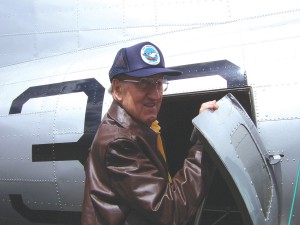
WWII B-17 pilot Ike Alhadeff, 90, steps aboard Aluminum Overcast for a short ride in the skies above Seattle.
“After flying for a short period of time around Tucson, I realized why I was so darned tired after an eight-hour mission in one of these,” he recalled.
“To me it was an easy airplane to fly,” remarked Alhadeff.
“It was,” agreed Reed. “Very forgiving. And it would take a lot of damage. In fact, mine was pretty badly damaged by the time we got out of it.” Turning to Alhadeff, Reed said, “I guess yours was, too.”
Watching the four big 1,200-hp Wright Cyclone radials turn the 11 foot, 7 inch diameter three-bladed propellers, Reed remembered the day when he and his crew were shot down over Germany. He was on his fifth mission, this one to Merseburg, and he was returning to England at the end of the bombing run. The date was Nov. 2, 1944.
“That airplane, the one I got shot down in, took a flak burst to the tail that took off the tail gunners guns—tore off the barrels,” said Reed. “It also damaged the vertical stabilizer and the left horizontal stabilizer.”
Another antiaircraft shell burst just off the number one engine, damaging it and forcing Reed to feather the prop. Just then the number one engine took a second blast of flak.
“That second blast folded one of the feathered props back over the cowling and sprayed the whole left side of the airplane with flak. It was noisy when that flak hit, too,” remembered Reed. “Just like you were in a tin can and people were throwing rocks at you.”
That second blast damaged the number two engine, but Reed managed to keep it going. But they were now on two and a half engines trying to keep up with the formation heading back to England. And that’s when the German fighters came up.
“A Focke-Wulf 190 got back on our tail ’cause we were tail-end Charlie that day,” said Reed. “The tail gunner didn’t have any guns. His barrels were gone. So, that Focke-Wulf managed to set us on fire.”
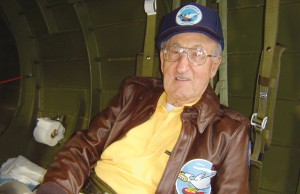
Ike Alhadeff, strapped in his seat for a short ride in the skies above Seattle, said, “It’s kind of fun being up in a B-17 again, but it’s not like it used to be.”
The nine crewmembers on board all were able to get out and all survived the bailout. In fact, they all survived internment in prison camps and the marches some had to make, and all managed to get back to the States. The 8th Air Force lost 40 B-17s that day.
“Of the three aircraft from our group that went down that day, my crew was the only one that managed to survive completely,” Reed said.
Ike Alhadeff was shot down, too, piloting his 23rd mission on Aug. 6, 1944.
“When you had to bail out of your aircraft, did all your crew survive?” Reed asked of Alhadeff.
“All mine survived, fortunately,” replied Alhadeff.
Both Alhadeff and Reed were captured by the Germans and sent to Stalag Luft III, the notorious Allied prisoner-of war camp run by the Luftwaffe near what is today Zagan, Poland. Only months before their separate captures had “The Great Escape” taken place at Stalag Luft III’s north compound. Alhadeff was interned in the north compound and Reed, who arrived sometime after, was put in the south compound.
On the night of Jan. 27, 1945, with the Russian army advancing on eastern Germany, Reed and Alhadeff, along with more than 10,000 fellow POWs, were mustered and then marched from the camp in bitterly cold conditions westward to Muskau, arriving January 29 after 2 a.m. On January 30 they were put aboard drafty boxcars at Spremberg for a rail journey to Stalag VIIA at Moosburg, 35 miles north of Munich.
“Stalag 7A wasn’t that far from Dachau,” said Reed. “It was originally built for 14,000 prisoners. By the end of the war there were more than 100,000.”
Elements of the 14th Armored Division of General George S. Patton’s 3rd Army liberated the camp on April 29, 1945. General Alexander M. Patch’s 7th Army was paralleling Patton and shortly after Stalag VIIA was liberated, Patch liberated Dachau.
Reed said the 7th Army people called up to Moosburg asking for Yiddish-speaking American volunteers to interpret for prisoners at Dachau.
“A friend of mine who now lives in Napa, California went down there,” said Reed. “He asked to be relieved because all he was doing was sorting out bodies. You got pretty tired of trying to pick up bodies and finding out whether they were alive or dead.”
The war was soon over, and for Reed and Alhadeff, liberation brought an end to their longest missions. Missions that had started in B-17s much like Aluminum Overcast.
Both veterans rode as guests aboard Aluminum Overcast that Wednesday afternoon on short flights over Seattle. On his flight, Reed sat up front behind the pilot, while Alhadeff chose to sit opposite the door back in the fuselage.
“It’s kind of fun being up in a B-17 again, but it’s not like it used to be,” said Alhadeff.
For complete information on EAA’s “Keep It Flying” tour, call 800-359-6217 or visit [http://www.B17.org]. For information regarding reunions of those who flew in and supported the air war in Europe, visit the 8th Air Force Historical Society website at [http://www.8thAFHS.org]. The 398th Bomb Group will have its 2006 reunion at Livonia, Mich. Sept. 6-9.











